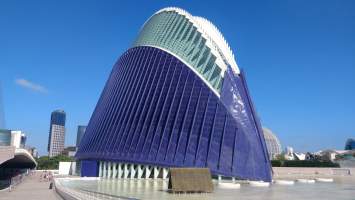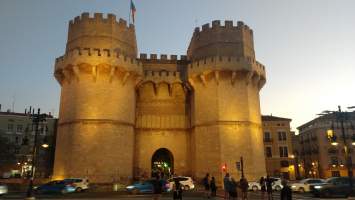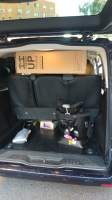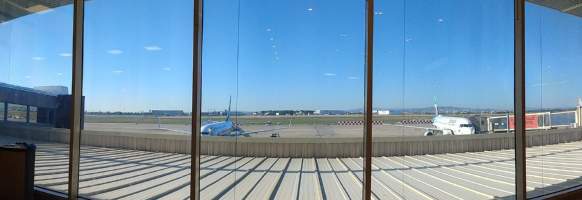Route
Torino–Sevilla the scenic way in 28 days, covering a number of severe gaps in my travels so far – including the town of Gap itself: the Izoard, the Pyrenees, the Basque Country, Africa (albeit just a tiny bit of it) and of course Spain as a whole.
Map of the route with the main climbs marked. (Made with UMAP.)
Outline
All 28 days add up to 4121 km of distance traveled on the bike, more than 600 km more than my longest four-week trip so far, Norway; that is an average of more than 147 km per day. Long distances to bridge between towns, especially in regions like that big void of La Mancha, without being able to wild camp anywhere resulted in a number of rather long days in the saddle. Altitude wise the total looks similarly big with 51845 m climbed and an average of 1851 m – almost one Mont Ventoux from sea level – per day, despite a few really flat days.
The main climbs this time were, in travel order:
-
Italy:
- Colle delle Finestre, 2176 m
- Sestriere, 2036 m
-
France:
- Col de Montgenèvre, 1850 m
- Col d’Izoard, 2360 m
- Mont Ventoux, 1910 m
- Mont Aigoual, 1565 m
- Col de Peyresourde, 1569 m
- Col d’Aspin, 1489 m
- Col du Tourmalet, 2115 m
-
Spain:
- Puerto de Larrau, 1573 m
- Picón Blanco, 1510 m
- Lagos de Covadonga, 1152 m
- Alto de l’Angliru, 1570 m
- Puerto de Pajares, 1378 m
- Puerto de Navacerrada, 1858 m
- Puerto de las Palomas, 1250 m
- Pico del Veleta, 3398 m
An illustrious list containing some of the hardest, highest and longest roads of the continent.
Impressions
With very few exceptions the road quality was excellent. Drivers in Spain in particular were civil and ultra patient, a breath of fresh air to those used to the maniacal German driving style. The one dangerous situation I do recall was caused by a moron with a Dutch license plate.
In terms of weather I got exceptionally lucky. No blizzards in the mountains, manageable headwind, sunny days. In central Spain I must have gone multiple days without spotting a single cloud in the sky. The little rain I had fell in northern Spain, that infamously humid region. It made Covadonga less pleasant than it might have been, but that was only for one day. All in all I probably had as many rainy days as I had dry days in four weeks of Norway last year; quite the opposite meteorologically speaking.
Highlights:
-
Col d’Izoard, the second highest point of altitude I reached after the Pico Veleta, and some of the most spectacular scenery I had the fortune to see with my own eyes. Typical for a French pass in the Alps, the gradient is never excessively steep. Also the low traffic and the number of cyclists on the road make it a fun ascent.
-
I didn’t have the Gorges de la Méouge on the radar before but they turned out the ideal prelude to Mont Ventoux.
-
The Cévennes and Mont Aigoual, in one word: paradise.
-
Pretty much all of the Basque Country was fun to ride in. Demanding due to the rolling hills, but at the same time the atmosphere was something else among those hundreds of cyclists I would encounter every day.
-
Of the three major steep climbs in northern Spain, Picón Blanco was the most memorable. The view up there is just so much better than at the Covadonga lakes, and the gradients, while challenging, don’t enter ridiculous territory as on the Angliru. Plus the Picón Blanco is not a dead-end like the other two, it is a pass road with a less steep descent in the northwest that actually feels like reward, not punishment, for making it up to the summit.
-
Of all the towns I passed through in central spain, Léon was my favorite: much more cycling friendly than Valladolid, prettier than Segovia, less confusing than Madrid.
-
The remote karstscape of the Lagunas de Ruidera surprised with an idyllic ensemble of lakes in a remote corner of La Mancha.
-
The literal high point of the trip was of course the Pico del Veleta. Lots of altitude, little air, and lots of like minded folks around. This mountain should not be missing from any trip to Andalucía. Plus now I get to call any road in Europe "low" like a real snob.
-
The magnificent mountain road up Ronda which really stood out in Andalucía. Pretty much the entire route from Malaga to the mountains and out of them on the other side was a great experience.
Let downs:
-
Anduze is quite tiny and the location on the Gardon between those rocks is not actually that picturesque. On top of that the lack of a usable water fountain reall spoiled the mood.
-
For a name as famous as the Col de Peyresourde that pass has little going for it: neither challenging nor overly visually stimulating. Just a long boring road with some switchbacks at the end.
-
Is it really a disappointment when you didn’t expect much in the first place and the sentiment turns out to be adequate? In any case Lourdes was every bit the tourist trap I imagined it to be.
-
Segovia province with its terrible roads and sparse road network. Not fun at all to move about up there.
-
Sevilla and the Guadalquivir plain: So flat that cycling down there bordered on boring. Actually most of the route since Tarifa during the final two days didn’t have a lot going for it. Felt a bit like cycling in the Netherlands.
Gear
Some new additions to the traveling gear that stood out in one way or the other:
-
Sea to Summit Ultra SIL Backpack: The most amazing piece of equipment to optimize logistics which makes extra space in the panniers unnecessary. Weighs practically nothing and packs down to a truly minimal size so it easily fits in the handlebar bag, but unpacked it can carry an evening’s worth of food and more.
-
Ortlieb Water-Bag drinking tube: Indispensable for a lightweight setup. The frame bag and fork cages were already occupying the bottle mounts, and due to the saddle bag I couldn’t use the tri style seatpost bottle cage adaptor. The solution was to move the water in the Ortlieb bladder and add the drinking hose adaptor to the latter, routed along the stem to the tri bars. Much less convenient to operate than bidons, but the flexible capacity is worth that. It takes some time getting used to drinking from a hose, especially when you’re already out of breath on a climb.
-
Cane Creek ViscoSet: The original steel fork of the Croix de Fer becomes problematic at around 45 km/h when the rotation of the wheel creates resonance with the fork. On steep descents this can be quite dangerous. After replacing the steel fork with the official carbon one that effect was marginally reduced but now occurs around 17 km/h. In a sort of last ditch attempt at getting rid of the vibrations I had the headset replaced with a ViscoSet that is designed to absorb those forces that arise in a loaded touring setup. It seems to work: the resonance is gone or at least very subdued now. Though that observation might be confounded by the different weight distribution and lighter load as the whole setup was around 8 kg lighter than the one I rode last year in Norway.
-
Ortlieb Handlebar Pack: The pack is definitely waterproof, I verified that in Asturias. I kept the Big Agnes tent in there which fit almost exactly between the drop bars but the folding style sealing mechanism comes with two disadvantages: a) The drop bars get in the way of removing the contents of the pack and loading it sideways. Not much of a problem with the tent as it has three separate pieces plus the poles and pegs which can all be packed separately. b) Even when packed snugly the closing mechanism sticks out at the sides and gets in the way of the integrated shifters. The fix to this would be for Ortlieb to rotate the pack 90 degrees around the sideways axis so the flap is vertical and thus parallel to the moving shifter, not intersecting it. Apart from that flaw there is nothing to critize about the Ortlieb pack; the combination with the detachable front bag is especially convenient.
-
Big Agnes Tiger Wall UL2 Bikepacking: An absolute marvel of a tent. The pole folds down to a more compact length so it fits between the drop bars. That alone is a solid reason to get this tent as pretty much none of the competitors in the ultralight tent space have a comparable pole design. It’s also both more spacious and lighter than my trusty old ALPS Lynx, and that’s including the additional footprint. Plus the separate footprint allows pitching the tent fly first which is quite handy in rainy situations – I did not experience those but I tried that pitchings style regardless and it turned out to be only marginally more complicated than the normal way. A significant upgrade, I just wish I had more opportunities to use the tent this time.
-
Electrolyte salts: A vast improvement over table salt to fight hyponatremia during dry, hot days. Also no more force feeding bananas for potassium which frees up quite some space in the bags.
The Voyage Home
Als always traveling with the bicycle on other modes of transportation is a hassle, and Spain is no different. First stop on the way home is Valencia, and equipped with the required travel bag I disassembled the bike and got on the Intercity train there. A bit disappointing that it wasn’t an AVE but at least it was a direct connection without transfer.
After spending a day in beautiful Valencia I again disassembled the bike, just more thoroughly than before, to fit it in a standard cardboard box for the flight to Munich. Getting the box to the airport turned out to be quite a challenge as local taxi services reserve larger vehicles for the disabled, so after trying various taxi apps I finally managed to book a "group" ride in some kind of small truck. With help from the patient driver we fit the box into his cab which wasn’t designed for transporting larger pieces of luggage either.
At the airport check-in accepted the box without so much as weighing it – I’m quite sure it was over the limit! – so it looks like I’ll have a hassle free flight back home after all.





